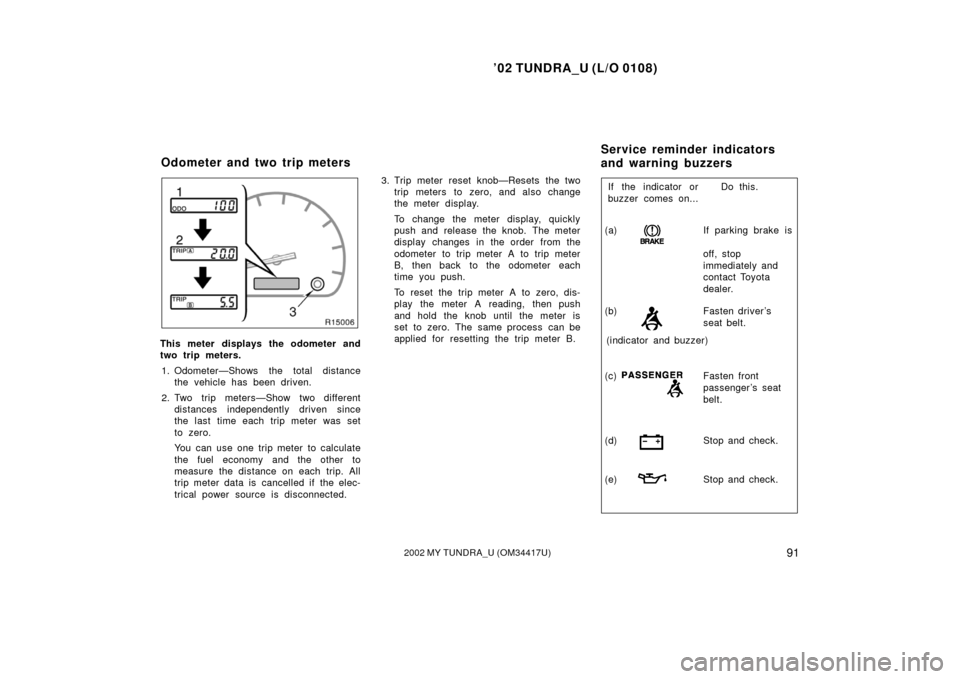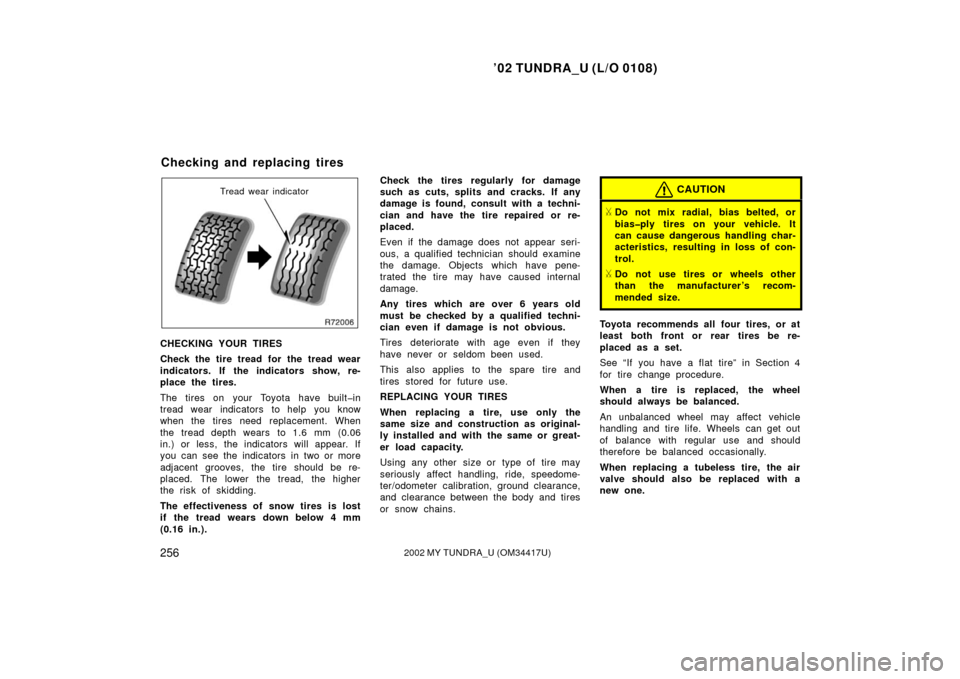Page 12 of 299
’02 TUNDRA_U (L/O 0108)
52002 MY TUNDRA_U (OM 34417U)
1. Oil pressure gauge
2. Service reminder indicators and
indicator lights
3. Tachometer 4. Speedometer
5. Automatic transmission indicator lights
6. Voltmeter
7. Fuel gauge8. Trip meter reset knob
9. Odometer and two trip meters
10. Engine coolant temperature gauge
Instrument cluster overview
� With tachometer
Page 13 of 299
’02 TUNDRA_U (L/O 0108)
62002 MY TUNDRA_U (OM 34417U)
1. Engine coolant temperature gauge
2. Service reminder indicators and
indicator lights 3. Speedometer
4. Fuel gauge
5. Trip meter reset knob
6. Odometer and two trip meters
�
Without tachometer
Page 94 of 299
’02 TUNDRA_U (L/O 0108)
872002 MY TUNDRA_U (OM 34417U)
OPERATION OF INSTRUMENTS AND
CONTROLS
Gauges, Meters and Service reminder indicators
Fuel gauge 88
. . . . . . . . . . . . . . . . . . . . . . . . . . . . . . . . . . . . \
. . . . . . . . . . . . .
Engine coolant temperature gauge 88
. . . . . . . . . . . . . . . . . . . . . . . . . . . .
Oil pressure gauge 89
. . . . . . . . . . . . . . . . . . . . . . . . . . . . . . . . . . . . \
. . . . . .
Vo ltme te r 90
. . . . . . . . . . . . . . . . . . . . . . . . . . . . . . . . . . . . \
. . . . . . . . . . . . . . .
Tachometer 90
. . . . . . . . . . . . . . . . . . . . . . . . . . . . . . . . . . . . \
. . . . . . . . . . . . .
Odometer and two trip meters 91
. . . . . . . . . . . . . . . . . . . . . . . . . . . . . . . . .
Service reminder indicators and warning buzzers 91
. . . . . . . . . . . . . . .
SECTION 1� 5
Page 98 of 299

’02 TUNDRA_U (L/O 0108)
912002 MY TUNDRA_U (OM 34417U)
This meter displays the odometer and
two trip meters.
1. Odometer—Shows the total distance the vehicle has been driven.
2. Two trip meters—Show two different distances independently driven since
the last time each trip meter was set
to zero.
You can use one trip meter to calculate
the fuel economy and the other to
measure the distance on each trip. All
trip meter data is cancelled if the elec-
trical power source is disconnected. 3. Trip meter reset knob—Resets the two
trip meters to zero, and also change
the meter display.
To change the meter display, quickly
push and release the knob. The meter
display changes in the order from the
odometer to trip meter A to trip meter
B, then back to the odometer each
time you push.
To reset the trip meter A to zero, dis-
play the meter A reading, then push
and hold the knob until the meter is
set to zero. The same process can be
applied for resetting the trip meter B.
(a) If parking brake is
off, stop
immediately and
contact Toyota
dealer.
(b) Fasten driver ’s
seat belt.
(indicator and buzzer) If the indicator or
buzzer comes on...
Do this.
(c) Fasten front
passenger ’s seat
belt.
(d) Stop and check.
(e)Stop and check.
Odometer and two trip meters Service reminder indicators
an d warn in g bu zzers
Page 263 of 299

’02 TUNDRA_U (L/O 0108)
2562002 MY TUNDRA_U (OM 34417U)
Tread wear indicator
CHECKING YOUR TIRES
Check the tire tread for the tread wear
indicators. If the indicators show, re-
place the tires.
The tires on your Toyota have built�in
tread wear indicators to help you know
when the tires need replacement. When
the tread depth wears to 1.6 mm (0.06
in.) or less, the indicators will appear. If
you can see the indicators in two or more
adjacent grooves, the tire should be re-
placed. The lower the tread, the higher
the risk of skidding.
The effectiveness of snow tires is lost
if the tread wears down below 4 mm
(0.16 in.). Check the tires regularly for damage
such as cuts, splits and cracks. If any
damage is found, consult with a techni-
cian and have the tire repaired or re-
placed.
Even if the damage does not appear seri-
ous, a qualified technician should examine
the damage. Objects which have pene-
trated the tire may have caused internal
damage.
Any tires which are over 6 years old
must be checked by a qualified techni-
cian even if damage is not obvious.
Tires deteriorate with age even if they
have never or seldom been used.
This also applies to the spare tire and
tires stored for future use.
REPLACING YOUR TIRES
When replacing a tire, use only the
same size and construction as original-
ly installed and with the same or great-
er load capacity.
Using any other size or type of tire may
seriously affect handling, ride, speedome-
ter/odometer calibration, ground clearance,
and clearance between the body and tires
or snow chains.
CAUTION
�Do not mix radial, bias belted, or
bias�ply tires on your vehicle. It
can cause dangerous handling char-
acteristics, resulting in loss of con-
trol.
�Do not use tires or wheels other
than the manufacturer ’s recom-
mended size.
Toyota recommends all four tires, or at
least both front or rear tires be re-
placed as a set.
See “If you have a flat tire” in Section 4
for tire change procedure.
When a tire is replaced, the wheel
should always be balanced.
An unbalanced wheel may affect vehicle
handling and tire life. Wheels can get out
of balance with regular use and should
therefore be balanced occasionally.
When replacing a tubeless tire, the air
valve should also be replaced with a
new one.
Checking and replacing tires